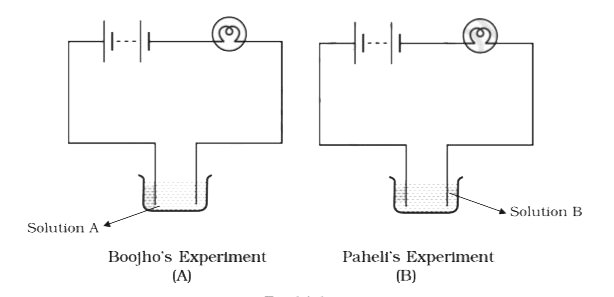A tester is used to check the conduction of electricity through two liquids, labelled A and B. It is found that the bulb of the tester glows brightly for·liquid A while it glows very dimly for liquid B. What conclusion would you draw?
liquid A is a better conductor than liquid B.
liquid Bis a better conductor than liquid A.
both liquids are equally conducting.
conducting properties of liquid cannot be compared.
The correct Answer is:A
Step by step video, text & image solution for A tester is used to check the conduction of electricity through two liquids, labelled A and B. It is found that the bulb of the tester glows brightly for·liquid A while it glows very dimly for liquid B. What conclusion would you draw? by Physics experts to help you in doubts & scoring excellent marks in Class 8 exams.
Updated on:21/07/2023Topper's Solved these Questions
- CHEMICAL EFFECTS OF ELECTRIC CURRENTBOOK - PEARSON IIT JEE FOUNDATIONCHAPTER - CHEMICAL EFFECTS OF ELECTRIC CURRENTEXERCISE - CLASSROOM CORNER (COMPREHENSION-BASED QUESTIONS)
5 Videos
- CHEMICAL EFFECTS OF ELECTRIC CURRENTBOOK - PEARSON IIT JEE FOUNDATIONCHAPTER - CHEMICAL EFFECTS OF ELECTRIC CURRENTEXERCISE - CLASSROOM CORNER (SUBJECTIVE TYPE QUESTIONS)
13 Videos
- CHEMICAL EFFECTS OF ELECTRIC CURRENTBOOK - PEARSON IIT JEE FOUNDATIONCHAPTER - CHEMICAL EFFECTS OF ELECTRIC CURRENTEXERCISE - HOTS
10 Videos
- KINEMATICSBOOK - PEARSON IIT JEE FOUNDATIONCHAPTER - KINEMATICSEXERCISE - LEVEL 3
18 Videos
- DYNAMICSBOOK - PEARSON IIT JEE FOUNDATIONCHAPTER - DYNAMICSEXERCISE - CONCEPT APPLICATION(LEVEL 3)
15 Videos
Similar Questions
A tester is used to check the conduction of electricity through two liquids, labelled A and B. It is found that the bulb of the tester glows brightly for liquid A while it glows very dimly for liquid B. You would conclude that
(i) liquid A is a better conductor than liquid B.
(ii) liquid B is a better conductor than liquid A.
(iii) both liquids are equally conducting.
(iv) conducting properties of liquid cannot be compared in this manner.
View SolutionUsing the 'conduction tester on an objectit was found that the bulb begins to glow. Is that object a conductor or an insulator? Explain.
View Solution
Knowledge Check
A tester is used to check the conduction of electricity through two liquids, labelled A and B. It is found that the bulb of the tester glows brightly for·liquid A while it glows very dimly for liquid B. What conclusion would you draw?
Aliquid A is a better conductor than liquid B.Bliquid Bis a better conductor than liquid A.Cboth liquids are equally conducting.Dconducting properties of liquid cannot be compared.
Boojho and Paheli performed experiments taking similar bulbs and cells but two different solutions A and B as shown in Fig.14.1.

They found that the bulb in the setup A glows more brightly as compared to that of the setup B. You would conclude that.
View SolutionUsing the ‘conduction tester’ on an object, it was found that the bulb begins to glow. Is the object a conductor or an insulator? Explain.
View SolutionUsing the 'conduction tester on an objectit was found that the bulb begins to glow. Is that object a conductor or an insulator? Explain.
View SolutionTwo identical containers A and B are filled with two different liquids of equal masses. The level of the liquid in container A is found to be one-fourth of the level of the liquid in container B. What is the ratio of thedensity of two liquids? If the density of he liquid in the container A is 2 " g "cm−3, then find the density of the mixture of the two liquids.
View SolutionTwo identical containers A and B are filled with two different liquids of equal masses. The level of the liquid in container A is found to be one-fourth of the level of the liquid in container B. What is the ratio of thedensity of two liquids? If the density of he liquid in the container A is 2 " g "cm−3, then find the density of the mixture of the two liquids.
View SolutionFig. 12.10 A and B, show a bulb connected to a cell in two different ways.

(i) What will be the direction of the current through the bulb in both the cases. (Q to P or P to Q)
(ii) Will the bulb glow in both the cases?
(iii)Does the brightness of the glowing bulb depend on the direction of current through it?
View SolutionWhen extremely small particles X derived from the anther of a flower were suspended in a liquid Y and observed through a microscope, it was found that the particles X were moving throughout the liquid Y in a very zig-zag way. It was also observed that warmer the liquid Y, faster the particles X moved on its surface.
What could particles X be ?
(b) What do you think liquid Y is ?
(c ) What is zig-zag movement of X known as ?
(d) What is causing the zig-zag movement of particles X ?
(e) Name the scientist who discovered this phenomenon.
(f) What does this experiment tell us about the nature of liquid Y ?
View Solution
